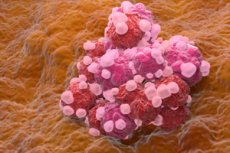
胶质母细胞瘤是一种侵袭性脑癌,目前尚无治愈方法。最近一项针对胶质母细胞瘤患者病历的研究发现,早晨接受化疗可使患者平均生存期延长3至6个月。
现在,圣路易斯华盛顿大学的一项研究报告称,胶质母细胞瘤细胞具有内置的昼夜节律,可以为治疗创造更有利的时间。
生物学家和临床医生已证实,在人类和小鼠胶质母细胞瘤的各种培养细胞系和分离株中,“时钟基因”的表达存在昼夜节律。这些节律与一种名为MGMT的DNA修复酶的昼夜节律活动相一致。
科学家随后进行了测试,发现当在一天中的某个时间(早上)进行化疗时,肿瘤细胞更容易死亡,因为此时肿瘤细胞的 MGMT 活性最低。
科学家们在患有胶质母细胞瘤的小鼠身上重复了他们的研究,发现与晚上给药相比,早上进行化疗可以缩小肿瘤大小并增加体重。
华盛顿大学文理学院生物学研究生、新研究的第一作者玛丽亚·F·冈萨雷斯·阿蓬特 (Maria F. Gonzalez-Aponte) 表示:“在细胞更容易受到影响的时间段使用药物可能有机会更好地治疗这种疾病。”
“我们发现,在人类和小鼠胶质母细胞瘤模型中,早晨主观给予替莫唑胺 (TMZ) 化疗可以显著减少肿瘤生长并改善治疗效果。”
“由于 TMZ 是在家中口服的,因此将这些结果转化为患者的结果相对简单,”新研究的通讯作者、艺术与科学学院 Victor Hamburger 杰出服务教授兼生物学教授 Eric D. Herzog 博士说。
赫尔佐格说:“我们需要进行额外的临床试验来证实我们的实验室发现,但目前的数据表明,只需要求患者在早上服用一种批准的药物,就可以改善胶质母细胞瘤的标准治疗。”
虽然针对 TMZ 和胶质母细胞瘤的每日时间管理实践研究很少,但研究作者指出,它已被证明可以改善几种癌症的治疗结果,包括急性淋巴细胞白血病、结直肠癌、卵巢癌和其他妇科癌症。
Joshua B. Rubin 医学博士、哲学博士,医学院儿科和神经科学教授,Herzog 实验室的长期合作者,也是该论文的共同作者。Gary J. Patti 博士,医学院文理学院和医学院化学教授,以及博士后研究员 Kevin Cho 博士(化学专业)也是该论文的共同作者。
这项研究的结果对于胶质母细胞瘤的治疗和诊断都有重要意义。
总体而言,被诊断为所谓 MGMT 甲基化肿瘤的胶质母细胞瘤患者对含有 TMZ 的化疗反应更好。
但这项研究表明,MGMT甲基化水平的升降取决于肿瘤的昼夜节律。因此,研究作者指出,医生需要考虑肿瘤活检的时间,以便正确地比较结果并改进诊断。
“尽管过去20年来进行了广泛的研究,但胶质母细胞瘤患者治疗后的中位生存期仍仅为15个月左右,这是一个令人担忧的统计数据,”赫尔佐格说。“引入色光疗法,或及时用药,或许有助于改善这种情况。”
该研究发表在《神经肿瘤学杂志》上。

